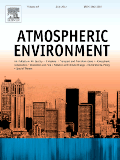
ATMOSPHERIC ENVIRONMENT
Scope & Guideline
Innovating research to tackle today’s atmospheric challenges.
Introduction
Aims and Scopes
- Air Quality and Pollution Studies:
Research focused on identifying, quantifying, and modeling the sources and effects of air pollutants such as PM2.5, NOx, VOCs, and ozone, including their health impacts and regulatory implications. - Atmospheric Chemistry and Physics:
Investigating the chemical and physical processes that govern atmospheric composition, including secondary organic aerosol formation, gas-phase reactions, and the interactions between aerosols and atmospheric gases. - Remote Sensing and Modeling:
Utilization of satellite data and advanced modeling techniques (e.g., WRF-Chem, CMAQ) to analyze atmospheric conditions, predict pollution levels, and assess the impacts of various environmental factors. - Health Impact Assessments:
Studies examining the relationships between air quality and public health, including the epidemiological impacts of pollution exposure on respiratory and cardiovascular diseases. - Climate Change Interactions:
Exploration of how atmospheric pollutants affect climate systems, including feedback mechanisms related to greenhouse gases and aerosols. - Local and Regional Studies:
Research that focuses on specific geographic areas to understand localized air quality issues, including urban heat islands, seasonal variations, and the influence of regional meteorological conditions.
Trending and Emerging
- Machine Learning and AI Applications:
The integration of machine learning techniques to improve air quality predictions, source apportionment, and data assimilation is rapidly emerging as a critical area of research, enhancing the accuracy and efficiency of atmospheric modeling. - Health Risk Assessments Related to Air Quality:
There is a growing emphasis on linking air pollution exposure to specific health outcomes, including long-term studies assessing chronic conditions and acute health impacts, reflecting a societal demand for more comprehensive health assessments. - Impact of Climate Change on Air Quality:
Research exploring how climate change influences air quality dynamics, including changes in meteorological patterns and their effects on pollutant formation and transport, has become increasingly relevant. - Interdisciplinary Approaches:
The blending of atmospheric studies with other fields such as public health, environmental justice, and urban planning is increasingly common, leading to holistic approaches in addressing air quality issues. - Real-Time Monitoring and Citizen Science:
Emerging trends in the use of low-cost air quality sensors and community-based monitoring initiatives are gaining popularity, providing real-time data and engaging the public in air quality issues.
Declining or Waning
- Traditional Source Apportionment Studies:
Although still relevant, the focus on classical methods for source apportionment has decreased as newer machine learning and advanced statistical techniques gain traction, leading to more nuanced analyses. - Longitudinal Studies of Static Pollutants:
There is a shift away from purely longitudinal studies that focus on static pollutants towards more dynamic models that consider real-time data and variability in emissions and meteorological conditions. - Single-Pollutant Focus:
Research concentrating solely on individual pollutants (e.g., CO, SO2) is declining in favor of multi-pollutant studies that better reflect the complexities of air quality and health impacts. - Localized Case Studies:
While case studies remain important, there is a noticeable trend towards broader regional assessments and comparative studies that leverage data from multiple locations, decreasing the frequency of localized studies.
Similar Journals
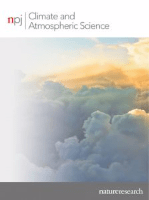
npj Climate and Atmospheric Science
Empowering scholars to address climate challenges.npj Climate and Atmospheric Science, published by NATURE PORTFOLIO, is a premier Open Access journal dedicated to advancing the understanding of climatic and atmospheric phenomena. Since its inception in 2018, this journal has positioned itself as a leader in its field, achieving Q1 ranking in 2023 across key categories such as Atmospheric Science, Environmental Chemistry, and Global and Planetary Change. With a Scopus rank of #23 out of 148 in Earth and Planetary Sciences and a commendable percentile ranking, npj Climate and Atmospheric Science serves as an essential platform for disseminating high-quality research, fostering interdisciplinary collaboration, and addressing critical global challenges. Its open access policy ensures that vital research findings are available to a broad audience, facilitating scholarly engagement and innovation. Researchers, professionals, and students in the fields of environmental science and climate studies will find this journal a valuable resource for cutting-edge studies and transformative insights.

Atmospheric Science Letters
Exploring the dynamics of our atmosphere.Atmospheric Science Letters, published by WILEY, is a leading open-access journal in the field of Atmospheric Science. Since its establishment in 2000, it has significantly contributed to advancing knowledge related to the Earth's atmosphere, focusing on both theoretical and practical aspects. With an impressive Q2 ranking in the Atmosphere Science category as of 2023 and a Scopus rank of 62 out of 148, this journal provides a platform for researchers and professionals to share their findings and insights. The journal’s commitment to open access since 2016 ensures that cutting-edge research is accessible to a global audience, fostering collaboration and innovation in the atmospheric sciences. Addressed from its headquarters at 111 River St, Hoboken, NJ, USA, Atmospheric Science Letters is pivotal for students, researchers, and professionals seeking to stay abreast of the latest developments in this dynamic field.

Tethys-Journal of Mediterranean Meteorology & Climatology
Exploring Climate Dynamics in the Heart of the MediterraneanTethys - Journal of Mediterranean Meteorology & Climatology, published by the Associació Catalana de Meteorologia (ACAM), serves as a specialized platform dedicated to advancing the study of meteorological and climatological phenomena within the Mediterranean region. With a Scopus Rank of #94 out of 148 in the field of Atmospheric Science, this journal is positioned in the Q4 category, reflecting a growing recognition among researchers focused on regional climate variations and environmental challenges. Established in 2012 and publishing through 2023, Tethys aims to provide open access to high-quality research articles that address critical issues impacting climate and weather patterns, thus contributing to a deeper understanding of Mediterranean meteorology. The journal’s mission aligns closely with the increasing global emphasis on climate studies and serves as an essential resource for academics, practitioners, and students dedicated to sustainably addressing the environmental and climatic challenges faced by this diverse and dynamic region.
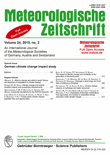
METEOROLOGISCHE ZEITSCHRIFT
Unlocking the Secrets of the AtmosphereMETEOROLOGISCHE ZEITSCHRIFT is a distinguished academic journal dedicated to the field of meteorology and atmospheric sciences, published by E SCHWEIZERBARTSCHE VERLAGSBUCHHANDLUNG. With an ISSN of 0941-2948 and an E-ISSN of 1610-1227, this journal has been an invaluable resource for researchers, professionals, and students since its inception. It has embraced an Open Access model since 2014, promoting wider dissemination of research findings. Based in Stuttgart, Germany, the journal is recognized for its rigorous peer-review process and is currently positioned in the Q3 quartile for Atmospheric Science as per the 2023 category rankings. Additionally, it ranks #97 out of 148 in the Scopus database, placing it in the 34th percentile among Earth and Planetary Sciences. Covering a broad spectrum of topics relevant to meteorology, METEOROLOGISCHE ZEITSCHRIFT serves as a platform for innovative research and theoretical contributions, aiming to advance understanding of atmospheric phenomena and their implications for climate and weather. Researchers and practitioners alike will find valuable insights within its pages, making it a significant asset in the landscape of meteorological scholarship.

METEOROLOGY AND ATMOSPHERIC PHYSICS
Elevating Knowledge in Meteorological SciencesMETEOROLOGY AND ATMOSPHERIC PHYSICS is a premier journal published by SPRINGER WIEN, dedicated to advancing the study of atmospheric phenomena and weather-related sciences. With an ISSN of 0177-7971 and an E-ISSN of 1436-5065, the journal has established itself as an important contributor in the field, particularly noted for its contributions in atmospheric science, holding a Q3 ranking in the 2023 category quartiles. Covering a wide array of topics from meteorological modeling to the physics of the atmosphere, it serves researchers, professionals, and students alike, facilitating the dissemination of significant findings and innovative research. The journal’s acceptance of articles until 2024 encourages a continuous influx of knowledge, and despite its lack of Open Access, it plays a crucial role in enriching the academic landscape for those engaged in Earth and planetary sciences, holding a commendable rank of 78 out of 148 in Scopus. Located in the scenic city of Vienna, Austria, the journal is positioned to harness the vibrancy of the academic community, providing a platform for valuable insights that can drive forward the field of meteorology and atmospheric physics.
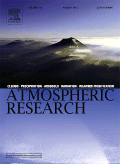
Atmospheric Research
Exploring the Dynamics of Our AtmosphereAtmospheric Research is a premier journal published by Elsevier Science Inc, specializing in the field of Atmospheric Science. With a commendable impact factor, it holds a distinguished position in the Scopus rankings, being placed 14th out of 148 journals within its category and achieving a remarkable 90th percentile rank. This journal serves as a vital outlet for rigorous research on atmospheric processes, climate variability, and meteorological phenomena, providing a platform for scientists, researchers, and students to disseminate their findings and contribute to the advancement of knowledge in this critical field. Although it is not an open-access journal, its strong reputation and selective publication criteria ensure that only high-quality and impactful studies are featured. Since its inception in 1986, Atmospheric Research has continuously evolved to meet the dynamic nature of atmospheric studies, making it a fundamental resource for anyone engaged in understanding and addressing atmospheric challenges worldwide.

Asia-Pacific Journal of Atmospheric Sciences
Navigating the Complexities of Climate ChangeWelcome to the Asia-Pacific Journal of Atmospheric Sciences, a leading publication in the field of atmospheric science, published by the Korean Meteorological Society. With an ISSN of 1976-7633 and an E-ISSN of 1976-7951, this journal has been a cornerstone for researchers and practitioners in the atmospheric sciences since its inception in 2008. Recognized for its rigorous peer-reviewed articles, it holds a commendable Q2 quartile ranking in 2023 and is placed at the 51st rank out of 148 in the Earth and Planetary Sciences, reflecting its impact within the community with a 65th percentile. The journal features a broad scope encompassing meteorology, climatology, and environmental sciences, making it an essential resource for scholars and industry experts alike. As an open access journal, it ensures that groundbreaking research is widely accessible, fostering collaboration and innovation across the Asia-Pacific region and beyond. Explore the latest findings and advancements in atmospheric sciences and contribute to the dynamic field of climate research through the journal's engaging content.
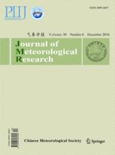
Journal of Meteorological Research
Fostering Innovation in Atmospheric and Oceanic Research.The Journal of Meteorological Research, published by SPRINGER HEIDELBERG, stands as a vital resource in the fields of Atmospheric Science and Ocean Engineering, boasting an impressive impact factor that reflects its scholarly significance. With its ISSN 2095-6037 and E-ISSN 2198-0934, the journal offers an open access platform, fostering accessibility and dissemination of cutting-edge research. Established in 2014 and running through to 2024, it is particularly distinguished in 2023 as Q2 in Atmospheric Science and Q1 in Ocean Engineering, underscoring its important contributions to these disciplines, with remarkable rankings in Scopus that place it in the top tiers of both categories. The journal accepts a broad range of research articles, reviews, and innovative methodologies, catering to a diverse audience of researchers, professionals, and students eager to advance their knowledge and expertise in meteorological studies. This makes the Journal of Meteorological Research an essential platform for anyone engaged in understanding and addressing the complex challenges of our changing climate.
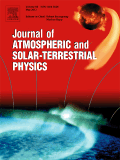
JOURNAL OF ATMOSPHERIC AND SOLAR-TERRESTRIAL PHYSICS
Advancing Knowledge in Atmospheric and Space SciencesJournal of Atmospheric and Solar-Terrestrial Physics, published by Pergamon-Elsevier Science Ltd, stands as a pivotal academic resource in the realms of Atmospheric Science, Geophysics, and Space and Planetary Science. With an ISSN of 1364-6826 and an E-ISSN of 1879-1824, this journal encompasses a robust collection of research findings and reviews that address the intricacies of atmospheric processes and solar-terrestrial interactions. The journal has shown consistent academic performance, earning commendable rankings in 2023, including Q3 in Atmospheric Science and Q2 in Geophysics, reflecting its importance for scholarly communication and advancement in these fields. Spanning an impressive convergence of research from 1997 to 2024, it aims to foster interdisciplinary collaboration and inspire innovations among researchers, professionals, and students. Although it currently does not offer open access, the journal is committed to disseminating high-quality content that continues to drive forward our understanding of complex environmental phenomena.
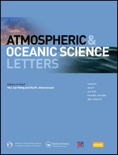
Atmospheric and Oceanic Science Letters
Bridging the Gap Between Atmosphere and OceanAtmospheric and Oceanic Science Letters is a premier open-access journal dedicated to the rapidly evolving fields of atmospheric science and oceanography. Published by KEAI PUBLISHING LTD, this journal aims to foster research dissemination and collaboration by providing a platform for high-quality research articles, reviews, and case studies that address critical issues impacting atmospheric and oceanic systems. With an impressive impact factor reflecting its esteemed position—including being ranked Q2 in Atmospheric Science and Q1 in Oceanography in 2023—this journal is an essential resource for researchers, professionals, and students alike. The journal's Open Access model, adopted since 2016, ensures that groundbreaking research is readily available to a global audience, enhancing knowledge transfer and facilitating innovative solutions to environmental challenges. Operating out of the United Kingdom and reaching an international readership, Atmospheric and Oceanic Science Letters plays a pivotal role in shaping our understanding of the interactions between the atmosphere and oceans, making it a vital publication for anyone aiming to stay at the forefront of these dynamic scientific fields.